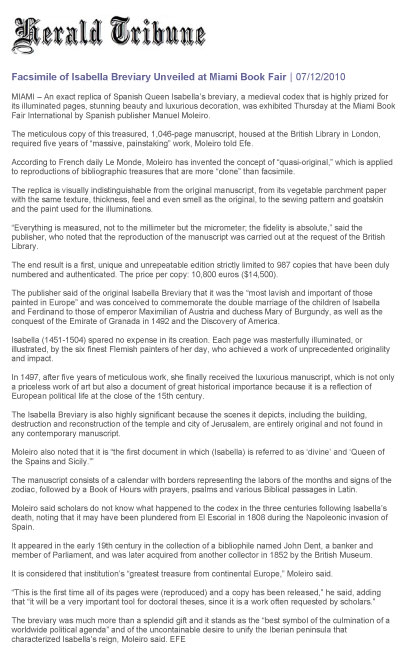Facsimile of Isabella Breviary Unveiled at Miami Book Fair
MIAMI - An exact replica of Spanish Queen Isabella's breviary, a medieval codex that is highly prized for its illuminated pages, stunning beauty and luxurious decoration, was exhibited Thursday at the Miami Book Fair International by Spanish publisher Manuel Moleiro.
The meticulous copy of this treasured, 1,046-page manuscript, housed at the British Library in London, required five years of "massive, painstaking" work, Moleiro told Efe. According to French daily Le Monde, Moleiro has invented the concept of "quasi-original," which is applied to reproductions of bibliographic treasures that are more "clone" than facsimile. The replica is visually indistinguishable from the original manuscript, from its vegetable parchment paper with the same texture, thickness, feel and even smell as the original, to the sewing pattern and goatskin and the paint used for the illuminations. "Everything is measured, not to the millimeter but the micrometer; the fidelity is absolute," said the publisher, who noted that the reproduction of the manuscript was carried out at the request of the British Library.
The end result is a first, unique and unrepeatable edition strictly limited to 987 copies that have been duly numbered and authenticated. The price per copy: 10,800 euros ($14,500). The publisher said of the original Isabella Breviary that it was the "most lavish and important of tose painted in Europe" and was conceived to commemorate the double marriage of the children of Isabella and Ferdinand to those of emperor Maximilian of Austria and duchess Mary of Burgundy, as well as the conquest of the Emirate of Granada in 1492 and the Discovery of America.
Isabella (1451-1504) spared no expense in its creation. Each page was masterfully illuminated, or illustrated, by the six finest Flemish painters of her day, who achieved a work of unprecedented originality and impact. In 1497, after five years of meticulous work, she finally received the luxurious manuscript, which is not only a priceless work of art but also a document of great historical importance because it is a reflection of European political life at the close of the 15th century. The Isabella Breviary is also highly significant because the scenes it depicts, including the building, destruction and reconstruction of the temple and city of Jerusalem, are entirely original and not found in any contemporary manuscript. Moleiro also noted that it is "the first document in which (Isabella) is referred to as 'divine' and 'Queen of the Spains and Sicily.' "The manuscript consists of a calendar with borders representing the labors of the months and signs of the zodiac, followed by a Book of Hours with prayers, psalms and various Biblical passages in Latin. Moleiro said scholars do not know what happened to the codex in the three centuries following Isabella's death, noting that it may have been plundered from El Escorial in 1808 during the Napoleonic invasion of Spain. It appeared in the early 19th century in the collection of a bibliophile named John Dent, a banker and member of Parliament, and was later acquired from another collector in 1852 by the British Museum.
It is considered that institution's "greatest treasure from continental Europe," Moleiro said. "This is the first time all of its pages were (reproduced) and a copy has been released," he said, adding that "it will be a very important tool for doctoral theses, since it is a work often requested by scholars."
The Breviary was much more than a splendid gift and it stands as the "best symbol of the culmination of a worldwide political agenda" and of the uncontainable desire to unify the Iberian peninsula that characterized Isabella's reign, Moleiro said. EFE
